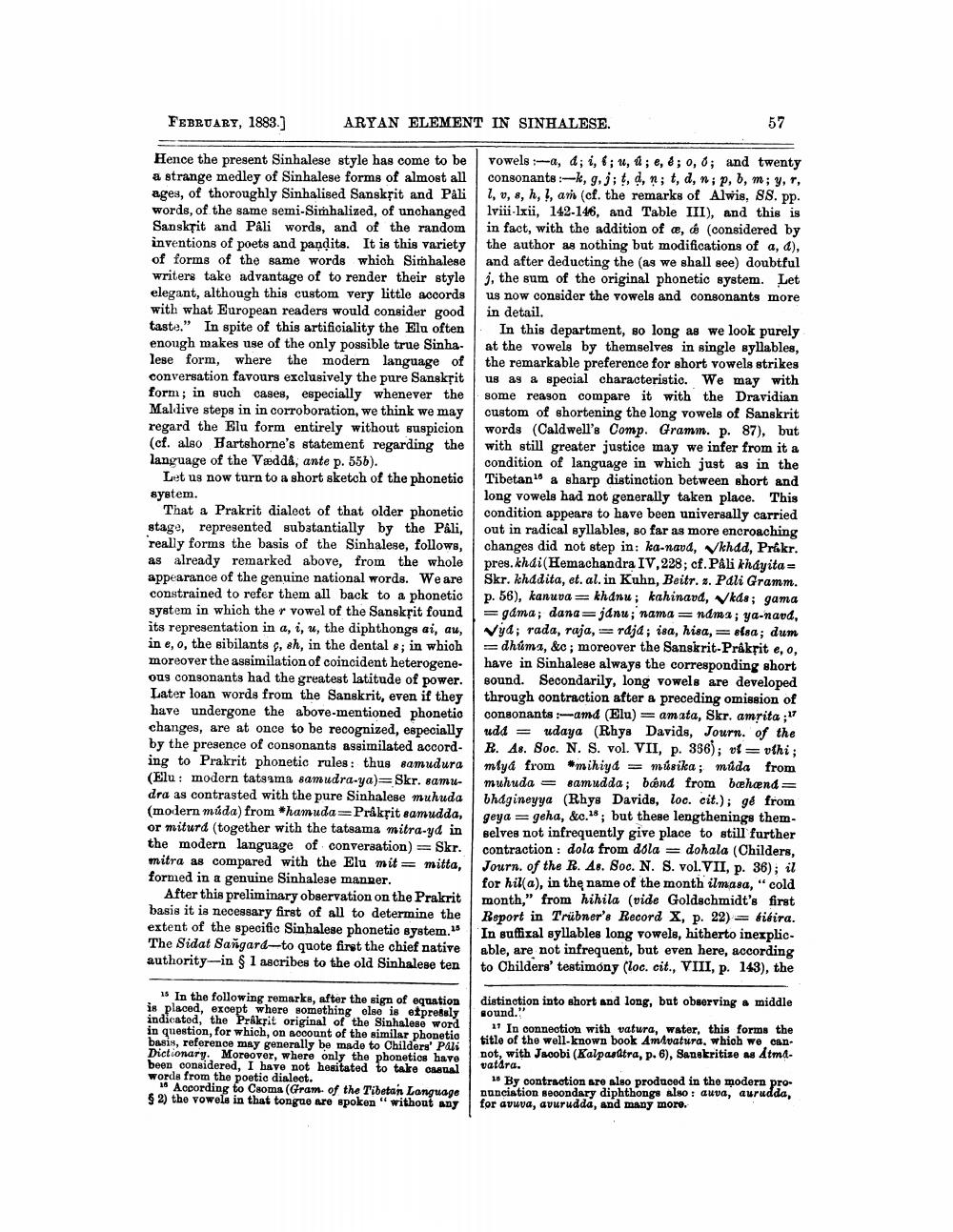________________
FEBRUARY, 1883.)
ARYAN ELEMENT IN SINHALESE.
57
Hence the present Sinhalese style has come to be vowels :-a, d; i, &; , ; e, &; 9,0; and twenty a strange medley of Sinhalese forms of almost all consonants :-k,g, j; $, d, n; t, d, n, p, b, m; y, T, ages, of thoroughly Sinhalised Sanskpit and Pali 1, 3, 8, h, !, aris (cf. the remarks of Alwis, 88. pp. words, of the same semi-Simhalized, of unchanged lviii-lxii, 142-146, and Table III), and this is Sanskpit and Páli words, and of the random in fact, with the addition of e, considered by inventions of poets and pandits. It is this variety the author as nothing but modifications of a, d), of forms of the same words which Sinhalese and after deducting the (as we shall see) doubtful writers take advantage of to render their style j, the sum of the original phonetic system. Let elegant, although this custom very little accords us now consider the vowels and consonants more with what European readers would consider good in detail. taste." In spite of this artificiality the Elu often . In this department, so long as we look purely enough makes use of the only possible true Sinha- at the vowels by themselves in single syllables, lese form, where the modern language of the remarkable preference for short vowels strikes conversation favours exclusively the pure Sansksit us as a special characteristic. We may with form; in such cases, especially whenever the some reason compare it with the Dravidian Maldive steps in in corroboration, we think we may custom of shortening the long vowels of Sanskrit regard the Elu form entirely without suspicion words (Caldwell's Comp. Gramm. p. 87), but (cf. also Hartshorne's statement regarding the with still greater justice may we infer from it a language of the Vædda, ante p. 55b).
condition of language in which just as in the Let us now turn to a short sketch of the phonetic Tibetan a sharp distinction between short and system.
long vowels had not generally taken place. This That a Prakrit dialect of that older phonetic condition appears to have been universally carried stage, represented substantially by the Pali, out in radical syllables, so far as more encroaching really forms the basis of the Sinhalese, follows, changes did not step in: ka-navd, khdd, Príkr. as already remarked above, from the whole pres.khdi(Hemachandra IV,228; cf.Pali kháyita= appearance of the genuine national words. We are Skr. khddita, et. al. in Kuhn, Beitr... Pali Gramm. constrained to refer them all back to a phonetic p. 56), kanuva = khanu; kahinavd, Vkda; gama system in which the r vowel of the Sanskrit found =gama; dana=janu; nama =ndma; ya-nand, its representation in a, i, u, the diphthonga ai, au, Vyd; rada, raja, rdjd; isa, hisa, = slaa; dum in e, o, the sibilants ç, sh, in the dental 8; in which =dhúma, &c; moreover the Sanskrit-Prakrit e, o, moreover the assimilation of coincident heterogene. have in Sinhalese always the corresponding short ous consonants had the greatest latitude of power. Bound. Secondarily, long vowels are developed Later loan words from the Sanskrit, even if they through contraction after a preceding omission of have undergone the above-mentioned phonetio consonants :-amd (Elu) = amata, Skr. amrita ;" changes, are at once to be recognized, especially udd = udaya (Rhys Davids, Journ. of the by the presence of consonants assimilated accord R. As. Soc. N. S. vol. VII, p. 356); v = vthi; ing to Prakrit phonetic rules: thus samudura mlyd from *mihiyd = músika; müda from (Elu: modern tatsama samudra-ya)=Skr. sama- muhuda = samudda; band from bæhænd= dra as contrasted with the pure Sinhalese muhuda thagineyya (Rhys Davids, loc. cit.); g& from (modern múda) from *hamuda=Prakrit samudda, geya = geha, &c.; but these lengthenings themor miturd (together with the tatsama mitra-yd in selves not infrequently give place to still further the modern language of conversation) ==Skr. contraction : dola from déla = dohala (Childers, mitra as compared with the Elu mit = mitta, Journ of the R. As. Soc. N. S. vol. VII, p. 36); il formed in a genuine Sinhalese manner.
for hilla), in the name of the month ilmasa," cold After this preliminary observation on the Prakrit month," from hihila (vide Goldschmidt's first basis it is necessary first of all to determine the Report in Trübner's Record X, p. 22) = fibira. extent of the specific Sinhalese phonetio system. In suffixal syllables long vowels, hitherto inexplicThe Sidat Sangard-to quote first the chief native able, are not infrequent, but even here, according authority-in & 1 ascribes to the old Sinhalese ten to Childers' testimony (loc. cit., VIII, p. 143), the
18 In the following remarks, after the sign of equation is placed, except where something else is etpressly indicated, the Prakrit original of the Sinhalese word in question, for which, on account of the similar phonetio basis, reference may generally be made to Childers' Pali Dictionary. Moreover, where only the phonetics have been considered, I have not hesitated to take onsual words from the poetic disleet.
1 According to Csoma (Gram of the Tibetan Language $ 2) the vowels in that tongue are spoken" without any
distinction into short and long, but observing middle sound."
11 In connection with vatura, water, this forms the title of the well-known book Amivatura, which we can not, with Jacobi (Kalpastra, p. 6), Sanskritize as Atmavatra.
16 By contraction are also produced in the modern pronunciation secondary diphthongs also: auva, aurudda, for avuva, avurudda, and many more.




